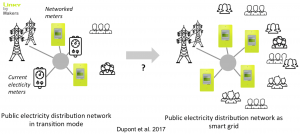Linky by Makers a Lorraine Smart Cities Living Lab project
WHY. What is the aim of the project
Linky by Makers (LbM) project explores the development of a user-driven innovation supporting French public electricity distribution network (PEDN), which is implementing its smart-meter program Linky. LbM project also establishes the requirements of the design of a smart PEDN supported by citizens.
 Evolution of the French context of electric energy (production, distribution, consummation)
Evolution of the French context of electric energy (production, distribution, consummation)
WHAT: what is the project about?
Innovation driven by open communities has proven to have a significant potential. However, tools and methodologies enabling collaborative innovation involving open communities , in the perspective of creating open hardware to solve societal issues, remains at the early stages.
LbM project pinpoints the potentialities and challenges toward defining methods to better support a multi-stakeholders open source collaboration context. Lorraine Smart Cities Living Lab experimented with the diffusion of smart meters in France and their appropriation by open source communities, with the involvement of the university and a public industrial company (ENEDIS).
LbM seeks to study how these communities of users could develop in a collaborative manner, new products and services using the smart-meter as a support technology and transform it to a social innovation with ‘active’ acceptance supporting energy usage optimization.
Predicted shift from technological system to socio-technological ecosystem
HOW: Methodology & stakeholder engagement
To research team of the Living Lab designed a citizen research program involving academics, engineers from ENEDIS, the French electricity distributor, students and citizens as “makers”. Indeed, our team also involves a French FabLabs network, asked to communities of makers, of different French FL, to create new products and services based on the information and new functionalities of the smart meter.
Public events and FabLabs Network were implemented to promote the project. We used: our own digital platform supporting ideation; 2 digital collaborative platforms to communicate and share open source hardware. The project was supported by our innovation space: Lorraine Fab Living Lab http://www.lf2l.fr
The value produced by the participants is not dedicated to the company but to commons (all the citizens) under the principle of the open hardware.
FabLabs adopting a Living Lab approach
From Communities of Practices to Communities of Interest
IMPACT: Main outcomes (Top 3)
- Societal: This project, involving around 80 volunteers, shows the strong complementarity between Living Lab & FabLab supporting a geographically, culturally, technologically and temporally distributed PPPP
- Operational: Our project generates 30 new open hardware projects, 10 were turn into functional mock-ups. We identified potential economic developments with positive societal and sustainable impacts
- Scientific: Tools and Methods for Collaborative Innovation Projects Engaging open communities describe in a scientific paper at ICE / IEEE ITMC 2017 (https://hal.archives-ouvertes.fr/hal-01582548v1)
From Idea (concept) to Product (mock-up)
Open Source hardware production available at: https://github.com/LF2L
ACKNOWLEDGMENT
This project benefit from the Chaire REVES funds. Furthermore ERPI research team thanks for their valuable contributions and efforts: Manuel Zurita, ENEDIS, Regional FabLabs (NYBI, Artilect, FOL, FacLab) and all the involved makers, GSI Lab, Lorraine Fab Living Lab® team. Authors also thank Emmanuel Del Sordo, Hakim Boudahoud, Joëlle Mastelic and Marc Pallot for their advice and support.
Read More:
- Laurent Dupont, Alex Gabriel, Mauricio Camargo, Claudine Guidat. Collaborative Innovation Projects Engaging open communities: a Case Study on Emerging Challenges. 23rd ICE/IEEE International Conference on Technology, Management and Innovation, Jun 2017, Madeira Island, Portugal. 〈10.1109/ICE.2017.8280002〉. 〈hal-01582548〉: https://hal.univ-lorraine.fr/hal-01582548v1
- Dupont L., Mastelic J., Nyffeler N., Latrille S., Seulliet E.. Living lab as a support to trust for co-creation of value: application to the consumer energy market. Journal of Innovation Economics & Management, De Boeck Supérieur 2019, 28 (1), pp.53-78. 〈https://www.cairn.info/revue-journal-of-innovation-economics-2019-1-page-53.htm〉. 〈10.3917/jie.028.0053〉. 〈hal-02010217〉
- Dupont L., Mastelic J., Nyffeler N., Latrille S., Seulliet E. Confiance et Technologie : Deux Dimensions de l’Innovation Ouverte et Agile appliquée à l’Énergie. Technologie et innovation, ISTE OpenScience, 2019, 4 (1), 〈10.21494/ISTE.OP.2019.0314〉. 〈hal-02047441〉
- see also this page
FUTURE WORKS
Follow our new developments at the European level, with the H2020 Smagrinet project (capacity building 2019-2021) – https://www.smagrinet.eu/





